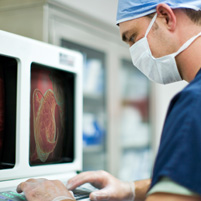Equipping Surgeons

It's an attractive field of research to a mechanical engineer, according to Ender Finol, and he is an expert in it.
Working closely with surgeons and scientists, the associate research professor at Carnegie Mellon University models blood vessels and designs medical devices.
"Many of the scientific principles and standard governing physics taught in the mechanical engineering curriculum can be applied or adapted to studying the human body," said Finol.
His latest research involves aortic aneurysms. Thirteen-thousand people die annually from aortic aneurysm rupture in the U.S. alone. Finol is developing a software program to help vascular surgeons better predict the risk of rupture.
With the new software, surgeons will be able to characterize the shape of aortic aneurysms using an automated, scientific and quantitative approach.
Currently, surgeons must rely on manual measurements of their size on a computed tomography (CT) scan.
"The software will allow doctors to assess the risk of rupture of an aneurysm in an individualized manner using geometric features that they currently cannot evaluate, since they base their assessment on estimating the maximum aneurysm diameter," said Finol, who is head of the Vascular Biomechanics and Biofluids Laboratory at Carnegie Mellon's Institute for Complex Engineered Systems (ICES).
Prevention of rupture is the key to clinical management of patients with aortic aneurysms.
"When doctors find an aneurysm, they measure its maximum diameter directly on the medical image — an ultrasound or CT — and if it is greater or equal than 5 or 5.5 centimeters (depending on the hospital), they recommend elective repair," Finol explained.
Not only can the software measure maximum aneurysm diameter, but it also estimates thirty or so other parameters related to the shape and size of the aneurysm.
"We believe these parameters are more important than diameter alone in assessing the individual risk of rupture of an aneurysm," Finol said.
CMU's geographic location is a clear advantage for doing research in cardiovascular disease, says Finol.
"The strong presence of Allegheny General Hospital and UPMC provide access to a wealth of clinical data and expertise that are ideal for studying aneurysms."
CMU also has strong academic programs in biomedical engineering, electrical and computer engineering and computer science.
"The programs provide numerous training opportunities for graduate students in medical image analysis, bioimaging, machine learning, biostatistics, for example — all of which are necessary for conducting research in image-based modeling of aortic aneurysms," Finol said.
Finol's research is funded by National Institutes of Health (NIH).
Related Links: Watch Video | Vascular Biomechanics at CMU | ICES
